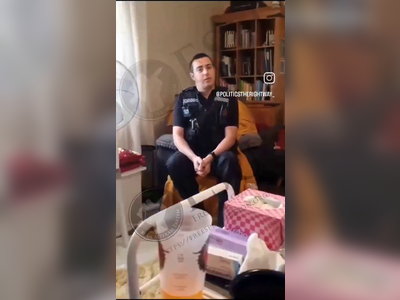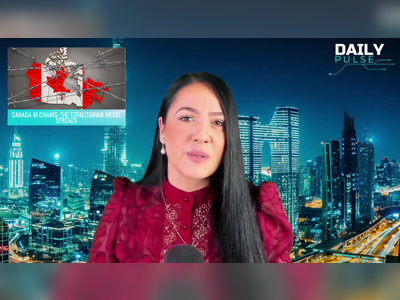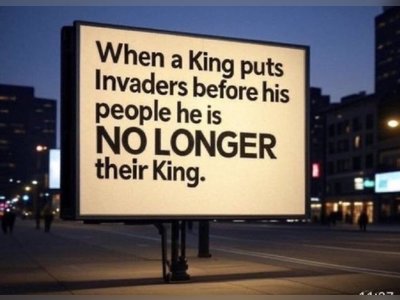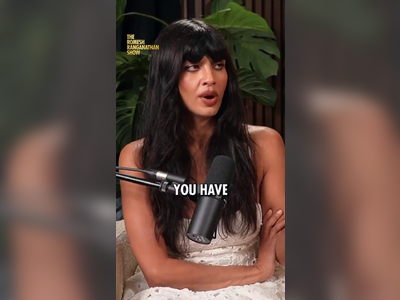
Lessons for American Police From Hong Kong
The city’s force had dubbed itself “Asia’s Finest.” Now it is seen by many as an occupying force.
For most of last year, life here was intertwined with protests. Those not attending demonstrations might have found themselves caught in the middle of a police clearance operation, with officers chasing black-clad protesters into subway stations or around shopping malls. Large video boards hanging off skyscrapers occasionally carried live footage of marches just a few blocks away. People distantly removed from the nucleus of unrest could count on live-streams on their phone. Even when I was not reporting, the protests were never far off: Dinners with friends sometimes came with a whiff of tear gas.
This week, I found myself once again staring at and scrolling through protest footage, not from the Hong Kong neighborhoods of Sha Tin, Yuen Long, and Causeway Bay, but from Minneapolis, Los Angeles, and Chicago. Watching from many time zones away, my mornings slipped by as I sat enraptured with news reports, checking my messages for updates from friends and family in the United States.
The protests that have rolled across the U.S. and the mass demonstrations in Hong Kong are undoubtedly different, both at their root and in how they have played out. Hong Kongers, for instance, point out that while buildings and businesses here were damaged, they were selective about targeting only pro-Beijing sites and tried to restrict looting. Some in Hong Kong have also posted photos to social media of American officers joining protesters in solidarity, remarking that such scenes would never take place here. (The reaction of those such as Senator Tom Cotton, a vocal backer of Hong Kong’s demonstrations who has supported cracking down on his own protesting citizenry, is one that hasn’t gone unnoticed by the government here or in Beijing.)
Still, it is difficult not to see a few similarities between the U.S. protests and, in particular, the early days of Hong Kong’s latest prodemocracy movement. If those parallels bear out over time, the U.S. could be looking at a long arc of protests, one in which the actions of the authorities do not quell unrest but instead galvanize demonstrators and draw in new ones, broadening protests into a movement far larger and with much wider support than when it began.
I remarked to friends this week that numerous American police departments appeared to be having their June 12 moment, a reference to a mass protest in Hong Kong last year that was violently broken up by officers, the first of many such crackdowns to come. The actions of police that day-attacking peaceful protesters, firing rubber bullets at journalists, and harassing bystanders-captured on video and widely broadcast, coupled with the authorities’ subsequent unflinching support of the force led to a surge in support for demonstrators, helping propel Hong Kong’s protests from ones focused on a single issue to a much larger movement.
Just days prior to the June 12 protest, hundreds of thousands of Hong Kongers had taken to the streets against proposed legislation that would have allowed extraditions to mainland China, worried and angry about the threat posed to the territory’s semiautonomous status. On June 12 itself, tens of thousands of protesters occupied a major road near the city’s Legislative Council, hoping to disrupt the reading of the bill. The effort started just after sunrise and within a few hours the street had turned into a well-organized protest camp. Supplies flowed from distribution points up and down the road, groups of friends sat on the pavement chatting, a few people placed enormous orders at a nearby McDonald’s and weaved through the crowd handing out hamburgers.
Then, in the late afternoon, police began firing canisters of tear gas as protesters pushed against metal barricades. It was early in Hong Kong’s period of unrest, and demonstrators were not yet wearing the body armor and helmets that would become commonplace in the weeks and months to come. With little protection, many of them fled in panic. Police then fired rubber bullets and bean-bag rounds, while some officers beat unarmed protesters with batons. Others fired on clearly identified journalists. Some officers removed their identification badge from their uniform, making it impossible to know who they were. After the dispersal, one protester teared up as he told me about the solidarity he had felt while demonstrating alongside strangers for a common goal, before officers intervened.
Police in Hong Kong would quickly find out what officers in the U.S. could soon be discovering themselves: that while tear gas momentarily sends people scattering, when the smoke clears, it has a way of bringing people together, turning bystanders into protesters and hardening the resolve of those already committed to a cause.
Nearly every person I spoke with in the following year-frontline protesters, activists, prodemocracy lawmakers, and casual participants in the demonstrations-cited June 12 as a turning point. “It changed everything,” Bonnie Leung, who at the time served as the vice convener of the Civil Human Rights Front, a group that organized some of the largest protests against the extradition bill, told me.
The main grievance, the proposed legislation, remained, but the actions of the police shocked and appalled many, leading to more people joining the protests. Two days later, thousands of mothers took part in a rally urging police to not shoot their kids. On June 16, some 2 million people took to the streets, the largest protest of the movement and one of the largest in Hong Kong’s history. The following month, on July 21, police failed to quickly respond to organized-crime members beating protesters with sticks, further eroding trust. Images this week of white residents of a Philadelphia neighborhood carrying bats and assaulting people while police stood by were strikingly similar. (Just as in Hong Kong, a journalist in Philadelphia was also targeted.) Poor attempts by law enforcement in the U.S. to make people second guess what they have seen, are reminiscent of the Hong Kong police’s defense when they were caught on camera roughing up a man on the ground. It was just a “yellow object,” officers claimed. Even now, graffiti marking the dates of these incidents in Hong Kong can still be seen around the city.
Police did not simply fail to keep order and curtail the protests-the task they were sent to the streets to do. The reputation of the Hong Kong Police Force, which dubbed itself “Asia’s Finest” and was generally respected as recently as a year ago, collapsed in the eyes of those it purported to serve. At the same time, radical tactics used by protesters became more accepted by the public. Officers now walking the streets are routinely on the receiving end of vulgarities and slurs, and have moved from being seen as arbiters of law and order to being viewed as an occupying force working at the behest of Beijing. Researchers at the Chinese University of Hong Kong described police as being “perceived as a coercive apparatus of the People’s Republic of China” in a paper detailing how violent confrontations led to an uptick in support for prodemocracy candidates in last year’s local elections.
An interview with a young woman by the online news outlet Asian Boss captured not only the anger but the deep sadness that many people felt watching the police brutalize city residents with seemingly little remorse and no repercussions. “When I was young, my teacher told me that the police arrest criminals, and you can seek help from them and you can trust them,” the woman said as she began to cry. “I couldn’t imagine being afraid of being hit and arrested by the police. But now, even though I might not be breaking any laws, I might get arrested or hit by them for just wearing a black T-shirt.” Recently, my soft-spoken Cantonese teacher, when going through a section on useful phrases, told me that “Help, I’m in trouble!” used to be something I could have said to get a police officer’s attention. Now it would more likely be deployed when an officer was beating me indiscriminately, she said.
The lessons for the United States appear clear, even if the parallels are not perfectly aligned. It took decades for Hong Kong’s police to build up a store of trust, and mere days for that trust to be lost. The authorities’ unquestioning support of the police, absolving officers caught misusing their power and refusing demands for a substantive inquiry into the force, has only served to worsen the relationship between the city’s people and those charged with keeping them safe.
A significant difference, however, between American police departments and the force here, which prodemocracy advocates have been quick to point out and which Hong Kong’s government likes to overlook, is that out-of-control officers in the United States face at least some repercussions. A number have been fired, and investigations have been launched. It’s not the complete overhaul and rethinking of policing that some have advocated for, but it is start.
In Hong Kong, the government’s largely powerless police watchdog this year produced a 999-page report looking at the force’s conduct during the protests. Though it unsurprisingly absolved the police of wrongdoing, it nevertheless noted that “the image of the police has lost its lustre and the city of Hong Kong has lost its hard-earned reputation as a peaceful city.”
“Most disheartening, too,” it continued, “is the psychological trauma the violence has wrought, particularly on the minds of young people.”
This week, I found myself once again staring at and scrolling through protest footage, not from the Hong Kong neighborhoods of Sha Tin, Yuen Long, and Causeway Bay, but from Minneapolis, Los Angeles, and Chicago. Watching from many time zones away, my mornings slipped by as I sat enraptured with news reports, checking my messages for updates from friends and family in the United States.
The protests that have rolled across the U.S. and the mass demonstrations in Hong Kong are undoubtedly different, both at their root and in how they have played out. Hong Kongers, for instance, point out that while buildings and businesses here were damaged, they were selective about targeting only pro-Beijing sites and tried to restrict looting. Some in Hong Kong have also posted photos to social media of American officers joining protesters in solidarity, remarking that such scenes would never take place here. (The reaction of those such as Senator Tom Cotton, a vocal backer of Hong Kong’s demonstrations who has supported cracking down on his own protesting citizenry, is one that hasn’t gone unnoticed by the government here or in Beijing.)
Still, it is difficult not to see a few similarities between the U.S. protests and, in particular, the early days of Hong Kong’s latest prodemocracy movement. If those parallels bear out over time, the U.S. could be looking at a long arc of protests, one in which the actions of the authorities do not quell unrest but instead galvanize demonstrators and draw in new ones, broadening protests into a movement far larger and with much wider support than when it began.
I remarked to friends this week that numerous American police departments appeared to be having their June 12 moment, a reference to a mass protest in Hong Kong last year that was violently broken up by officers, the first of many such crackdowns to come. The actions of police that day-attacking peaceful protesters, firing rubber bullets at journalists, and harassing bystanders-captured on video and widely broadcast, coupled with the authorities’ subsequent unflinching support of the force led to a surge in support for demonstrators, helping propel Hong Kong’s protests from ones focused on a single issue to a much larger movement.
Just days prior to the June 12 protest, hundreds of thousands of Hong Kongers had taken to the streets against proposed legislation that would have allowed extraditions to mainland China, worried and angry about the threat posed to the territory’s semiautonomous status. On June 12 itself, tens of thousands of protesters occupied a major road near the city’s Legislative Council, hoping to disrupt the reading of the bill. The effort started just after sunrise and within a few hours the street had turned into a well-organized protest camp. Supplies flowed from distribution points up and down the road, groups of friends sat on the pavement chatting, a few people placed enormous orders at a nearby McDonald’s and weaved through the crowd handing out hamburgers.
Then, in the late afternoon, police began firing canisters of tear gas as protesters pushed against metal barricades. It was early in Hong Kong’s period of unrest, and demonstrators were not yet wearing the body armor and helmets that would become commonplace in the weeks and months to come. With little protection, many of them fled in panic. Police then fired rubber bullets and bean-bag rounds, while some officers beat unarmed protesters with batons. Others fired on clearly identified journalists. Some officers removed their identification badge from their uniform, making it impossible to know who they were. After the dispersal, one protester teared up as he told me about the solidarity he had felt while demonstrating alongside strangers for a common goal, before officers intervened.
Police in Hong Kong would quickly find out what officers in the U.S. could soon be discovering themselves: that while tear gas momentarily sends people scattering, when the smoke clears, it has a way of bringing people together, turning bystanders into protesters and hardening the resolve of those already committed to a cause.
Nearly every person I spoke with in the following year-frontline protesters, activists, prodemocracy lawmakers, and casual participants in the demonstrations-cited June 12 as a turning point. “It changed everything,” Bonnie Leung, who at the time served as the vice convener of the Civil Human Rights Front, a group that organized some of the largest protests against the extradition bill, told me.
The main grievance, the proposed legislation, remained, but the actions of the police shocked and appalled many, leading to more people joining the protests. Two days later, thousands of mothers took part in a rally urging police to not shoot their kids. On June 16, some 2 million people took to the streets, the largest protest of the movement and one of the largest in Hong Kong’s history. The following month, on July 21, police failed to quickly respond to organized-crime members beating protesters with sticks, further eroding trust. Images this week of white residents of a Philadelphia neighborhood carrying bats and assaulting people while police stood by were strikingly similar. (Just as in Hong Kong, a journalist in Philadelphia was also targeted.) Poor attempts by law enforcement in the U.S. to make people second guess what they have seen, are reminiscent of the Hong Kong police’s defense when they were caught on camera roughing up a man on the ground. It was just a “yellow object,” officers claimed. Even now, graffiti marking the dates of these incidents in Hong Kong can still be seen around the city.
Police did not simply fail to keep order and curtail the protests-the task they were sent to the streets to do. The reputation of the Hong Kong Police Force, which dubbed itself “Asia’s Finest” and was generally respected as recently as a year ago, collapsed in the eyes of those it purported to serve. At the same time, radical tactics used by protesters became more accepted by the public. Officers now walking the streets are routinely on the receiving end of vulgarities and slurs, and have moved from being seen as arbiters of law and order to being viewed as an occupying force working at the behest of Beijing. Researchers at the Chinese University of Hong Kong described police as being “perceived as a coercive apparatus of the People’s Republic of China” in a paper detailing how violent confrontations led to an uptick in support for prodemocracy candidates in last year’s local elections.
An interview with a young woman by the online news outlet Asian Boss captured not only the anger but the deep sadness that many people felt watching the police brutalize city residents with seemingly little remorse and no repercussions. “When I was young, my teacher told me that the police arrest criminals, and you can seek help from them and you can trust them,” the woman said as she began to cry. “I couldn’t imagine being afraid of being hit and arrested by the police. But now, even though I might not be breaking any laws, I might get arrested or hit by them for just wearing a black T-shirt.” Recently, my soft-spoken Cantonese teacher, when going through a section on useful phrases, told me that “Help, I’m in trouble!” used to be something I could have said to get a police officer’s attention. Now it would more likely be deployed when an officer was beating me indiscriminately, she said.
The lessons for the United States appear clear, even if the parallels are not perfectly aligned. It took decades for Hong Kong’s police to build up a store of trust, and mere days for that trust to be lost. The authorities’ unquestioning support of the police, absolving officers caught misusing their power and refusing demands for a substantive inquiry into the force, has only served to worsen the relationship between the city’s people and those charged with keeping them safe.
A significant difference, however, between American police departments and the force here, which prodemocracy advocates have been quick to point out and which Hong Kong’s government likes to overlook, is that out-of-control officers in the United States face at least some repercussions. A number have been fired, and investigations have been launched. It’s not the complete overhaul and rethinking of policing that some have advocated for, but it is start.
In Hong Kong, the government’s largely powerless police watchdog this year produced a 999-page report looking at the force’s conduct during the protests. Though it unsurprisingly absolved the police of wrongdoing, it nevertheless noted that “the image of the police has lost its lustre and the city of Hong Kong has lost its hard-earned reputation as a peaceful city.”
“Most disheartening, too,” it continued, “is the psychological trauma the violence has wrought, particularly on the minds of young people.”










